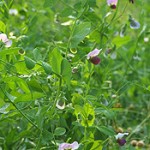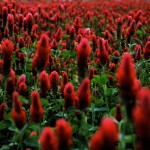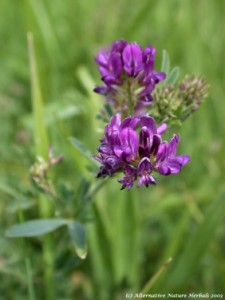The tyrannical heat that this summer has bestowed upon the south remains unrelenting. Sweat seeps while humidity hangs in the air like invisible wet cement. Besides bathing in ice, the only way to ignore the heat is to dream of the fall garden. Simple tasks like hoeing and direct sowing loses its oppressive air in the autumn. Thoughts don’t seem as stuffy, and the mind can wander to whimsical thoughts of planting without salty perspiration lathering the eyes.
One of the best preparatory method for future health of the garden are fall (or overwintering) cover crops (An overview of their benefits can be found in the last post) . Below are some of the more effective cover crops:
This legume may own the most sexually ambiguous titles thanks to being hailed as the “father of herbs” while also being known as the “queen of forages”. Besides its identity issues, alfalfa is an excellent nitrogen fixer as well as a superb feed for various livestock. Its high nutrition content of calcium, magnesium, potassium, Vitamin A, B-12, C, D, E, and K will turn any soil into a virtual multivitamin powerhouse when alfalfa is tilled under in the following spring. The crop can also be chopped down and dried into alfalfa meal or pellets, which can be used as fertilizers or homemade teas for the garden.
Austrian Winter Peas (aka black pea, field pea):
Austrian Winter Peas provide a plentiful nitrogen source while maintaining a good tolerance to old man winter. It’s very easy to turn under in the spring, and it keeps winter erosion under control.
Deer and turkey can’t resist its taste and a study in Kansas showed that under rotation, austrian winter peas could hinder soil borne pathogens that attack winter wheat and spring barley. The same study showed that cattle ingesting peas had increased lactation, which reduced winter hay feeding.
Crimson Clover:
The jack of all trades title belongs to the legume, crimson clover. It owns a high nitrogen fixing capability while also showing resistance to cold, moderate drought, and moderate to high shade tolerance. This beautiful legume needs to be planted approximately 40 days before the killing frost for optimal overwinter establishment.

Although the grower may feel some attachment to the charismatic beauty of the crimson clover; he or she must overcome their aesthetic soft side and turn it under (mowing, tilling, etc.) by early bloom (usually in mid to late spring) when the flower color begins to ebb. This will result in the highest biomass aggregation.
Next Up: Hairy Vetch, Winter Rye, Winter Wheat and Barley


web-analyst says
When radiators in a hot-water system develop banging or hammering noises the problem is most often due to trapped air that cannot get out. Air gets into the system from the fresh water that is periodically added to the system (usually automatically) to replace water that evaporates or leaks out. The trapped air keeps the radiator from filling all the way with hot water, sometimes causing a pounding noise and almost always keeping the radiator from heating all the way across.
xcafe says
Fall-seeded cereal cover crops differ in ability to facilitate low-till organic bean (Phaseolus vulgaris) production in a short-season growing environment